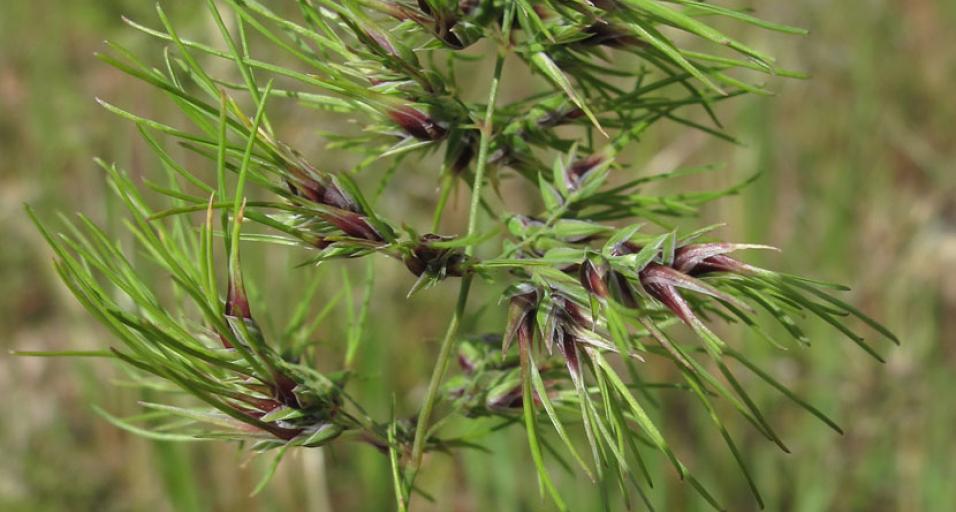Bulbous bluegrass, or Poa bulbosa, is a non-native, invasive plant found throughout Wyoming that tends to fly under the radar in many situations until it becomes well established. It is considered a short-lived perennial, cool season grass, and is the only grass known to have true bulbs. The bulbs are dormant from mid May through early October. When weather begins to cool in the fall, leaves emerge from the bulbs, and maintain slow growth through the winter. By early March the plant is typically several inches tall, and it cures out as soon as weather begins to warm during May and June.
The seed head of bulbous bluegrass is very striking with a plume-like appearance, and bulblets with purple bases and long bracts or awns attached to each bulblet. These bulblets provide the primary means of reproduction. Each bulblet is a mini-plant that can form roots and grow once it falls to the soil surface. Bulblet viability is relatively short, typically only two years. Bulbous bluegrass tends to favor disturbed soils in sites that are wet during fall and early spring. It is often found on the fringes of ephemeral wetlands and wet meadows, and is very common on the edges of crop and hayfields and along roads and two tracks. Due to its ability to capitalize on fall and early spring moisture, it is able to out-compete native perennial plants.
Wetland and wet meadow habitats are very important to many wildlife species, so any plant that impacts the diversity of those habitats is of concern to habitat managers. Bulbous bluegrass does have grazing value early, similar to cheatgrass, but once this grass has gone to seed, it provides little forage value to livestock or other grazing animals. Intensive grazing early in the spring, usually March and April, can reduce bulbous bluegrass infestations if targeted intensive grazing is applied over a period of several growing seasons. However, over-grazing of desirable perennial plants adjacent to bulbous bluegrass stands will allow it to spread. Interestingly, the bulblets are very high in starch and fat, and are sought after by some birds and small mammals, which provides a mechanism for its spread.
An effective method of control has not been found for bulbous bluegrass. In crop fields, early season tillage can provide control, but machinery can also spread the bulblets to other areas of the field and provide disturbance allowing establishment. The plant is easily pulled due to its shallow roots, but pulling may not be practical once bulbous bluegrass has become established on a site. There are limited chemical options labeled for bulbous bluegrass control in rangeland or pastureland settings-sulfometuron methyl (Landmark XP©), glyphosate (Roundup©), or rimsulfuron (Matrix©), may all be used for control, but all may cause damage to native plants or crops if misapplied. As with any chemical herbicide, discuss collateral damage to other plant species and other implications with your local Weed and Pest District prior to application. Bulbous bluegrass is a listed noxious weed species in Natrona County.
---
Story by Amy Anderson, Game and Fish Habitat Biologist
Photo source: http://science.halleyhosting.

